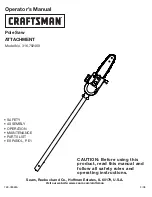
eNgliSh
27
From that point follow the chart straight down to find the correct
bevel angle and straight across to find the correct mitre angle.
0
5
10
15
20
25
30
35
40
45
0
5
10
15
20
25
30
35
40
45
5
10
15
20
25
30
35
40
45
5
10
15
20
25
30
35
40
5
10
15
20
25
30
35
40
45
50
55
60
65
70
75
80
85
5
10
15
20
25
30
35
40
45
50
55
60
65
70
75
80
85
5
10
15
20
25
30
35
40
45
50
55
60
65
70
75
80
85
SET THIS BEVEL ANGLE ON SAW
SET THIS MITER ANGLE ON SAW
ANGLE OF SIDE OF BOX (ANGLE"A"
)
SQUARE BOX
6 SIDED BOX
8 SIDED BOX
1. Set your saw to the prescribed angles and make a few trial cuts.
2. Practice fitting the cut pieces together.
Example: To make a four-sided box with 25° exterior angles
(angle “A”) (fig. 24), use the upper right arc. Find 25° on the arc
scale. Follow the horizontal intersecting line to either side to get
the mitre angle setting on the saw (23°). Likewise follow the vertical
intersecting line to the top or bottom to get the bevel angle setting
on the saw (40°). Always try cuts on a few scrap pieces of wood
to verify the settings on the saw.
WARNING:
Never exceed the compound mitre limits of
45° bevel with 45° left or right mitre.
support for short and long pieces (fig. 3)
CUTTinG shOrT maTeriaL
It is advisable to use the length stop (mm) for short workpieces both for
batch sawing and for short individual workpieces of different lengths.
The length stop can only be used in conjunction with a pair of optional
guide rails (ii).
CUTTinG LarGe maTeriaL
WARNING: To reduce the risk of injury,
always support
long workpieces.
Figure 3 shows the ideal configuration for sawing long workpieces when
the saw is used free-standing (all items available as an option).
These items (except the legstand and the material clamp) are required
both on the infeed and the outfeed side:
– Legstand (nn) (supplied with mounting instructions).
– Guide rails (500 or 1,000 mm) (ii).
– Stands (mm) to support the guide rails. Do not use the stands to
support the machine! The height of the stands is adjustable.
– Material support plates (jj).
– Table end plate (hh) for supporting the rails (also when working
on an existing bench).
– Material clamp (kk).
– Swivelling stop (ll).
1. Place your saw on the legstand and fit the guide rails.
2. Firmly screw the material support plates (jj) to the guide rails (ii).
3. The material clamp (kk) now functions as a length stop.
4. Install the table end plates (hh).
5. Install the swivelling stop (ll) to the rear rail.
6. Use the swivelling stop (ll) to adjust the length of medium and long
workpieces. It can be adjusted sideways or swung out of the way
when not in use.
Dust extraction (fig. 1, 6)
WARNING:
Whenever possible, connect a dust extraction
device designed in accordance with the relevant regulations
regarding dust emission.
Connect a dust collection device designed in accordance with the
relevant regulations. The air velocity of externally connected systems
shall be 20m/s +/- 2 m/s. Velocity to be measured in the connection
tube at the point of connection, with the tool connected but not
running.
A separate dust kit is available as an option (DE7777).
1. Fit the dust extraction tubes (qq) to the nozzles (q); the longer hose
to upper nozzle.
2. Connect the hoses to the three-way connector (rr).
Transporting (fig. 1)
WARNING:
In order to conveniently carry the mitre saw,
the base is provided with two hand indentations (ff).
1. To transport the saw, set the bevel and mitre positions to 0°.
2. Press the lower guard lock up release lever (b) (fig.1).
3. Press the head down and press the lock down button (w) (fig. 2).
4. Bring the saw blade to rest position and press the traverse lock (r).
mainTenanCe
Your D
e
WALT power tool has been designed to operate over a long
period of time with a minimum of maintenance. Continuous satisfactory
operation depends upon proper tool care and regular cleaning.
WARNING: To reduce the risk of injury, turn unit off
and disconnect machine from power source
before
installing and removing accessories, before adjusting or
changing set-ups or when making repairs. Be sure the
trigger switch is in the OFF position. An accidental
start-up can cause injury.
WARNING:
If the saw blade is worn replace it with a
new sharp blade.
Lubrication
Your power tool requires no additional lubrication.
Cleaning
WARNING:
Blow dirt and dust out of the main housing
with dry air as often as dirt is seen collecting in and around
the air vents. Wear approved eye protection and approved
dust mask when performing this procedure.
WARNING:
Never use solvents or other harsh chemicals
for cleaning the non-metallic parts of the tool. These
chemicals may weaken the materials used in these parts.
Use a cloth dampened only with water and mild soap.
Never let any liquid get inside the tool; never immerse any
part of the tool into a liquid.
WARNING: To reduce the risk of injury,
regularly clean
the table top.
WARNING: To reduce the risk of injury,
regularly clean
the dust collection system.
Summary of Contents for DW771
Page 1: ...www eu DW771 DW777 ...
Page 6: ...4 Figure 20 Figure 18 Figure 19 Figure 17 xx h a4 u a1 a2 a2 zz ee a3 t ...
Page 7: ...5 Figure 21 Figure 22 Figure 23 Figure 24 ...
Page 110: ......
Page 111: ......
















































